Suggestions for trees along tall privacy fence (PICS)
We are looking to add some additional privacy screening along our cedar fence in our backyard.
We are in Fairfield County, CT. Zone 6.
As you can see from the pictures, when we are sitting on our deck, we look right at the front stoop and side windows of our neighbors.
It is a somewhat narrow area. From the deck to the fence, it is about 17' wide.
We are looking to add some trees that would provide privacy ABOVE THE FENCE LINE.
Evergreens would be great, but not sure if that is possible. But we would be fine with non-evergreens, because there would be coverage during the non-winter months (which is when we typically use the deck).
Any ideas or suggestions would be great.
Thanks in advance.
Here are the pics:
View from the deck....The white railing in the distance is the neighbor's front door:
{{gwi:45077}}
Comments (63)
yourenglishgardener
15 years agolast modified: 9 years agoThe obvious answer is to get some 'pleached' trees. Lime (tila) and hornbeam are normally used for this purpose. You have 5 - 6 feet of trunk and then all the trained growth above (they look like a giant table tennis bat). Most are 1 foot wide by 6 feet in length. You may have to source them in your area and they may cost, but for instant effect you can't beat them.
Related Professionals
Bellflower Landscape Architects & Landscape Designers · Sand Springs Landscape Architects & Landscape Designers · Canton Landscape Contractors · Clearlake Landscape Contractors · Fuquay-Varina Landscape Contractors · Milton Landscape Contractors · Munster Landscape Contractors · York Landscape Contractors · Detroit Decks, Patios & Outdoor Enclosures · Palo Alto Decks, Patios & Outdoor Enclosures · Universal City Decks, Patios & Outdoor Enclosures · Elk Grove Swimming Pool Builders · Goodlettsville Swimming Pool Builders · Ontario Swimming Pool Builders · Roseville Swimming Pool Builderslaag
15 years agolast modified: 9 years agoI've mentioned this concept several times. It is to use height forward and lower vegetation behind it and in front of a fence. This example is an effective screen, but even if it did not completely block the view there is a psychological affect that makes what is in the background much less significant.
Notice how little space is used up by the hedge and trees. I believe the OP is looking to preserve as much of that small sideyard as possible.
I like the idea of fastigiate trees for this as well. Columnar Hornbeam is a very good and under used tree that could be used.
lpinkmountain
15 years agolast modified: 9 years agoGreat picture Laag! I've seen those columnar hornbean used to create allees. I've just never seen them at ye olde nursery. Also, pleaching was what I was thinking of, not really espalier. I think I got mixed up because apple trees are often use for espalier and pleached too. Google "pleached hedge" or "pleaching and plashing" for some cool ideas and pics.
I like the natural columnar look better, but you can do a lot with shaping trees if you have the patience for it.
laag
15 years agolast modified: 9 years agoI think the trees in the picture are Linden, if I remember correctly. They are not Columnar Hornbeams, if anyone was wondering. lpinkmountain was refering to a post farther above.
Saypoint zone 6 CT
15 years agolast modified: 9 years agoThanks for posting that photo, Andrew. I have a problem area that is now made up of a couple of hundred feet of Hemlock trees. Some of them are too tall, some are thin or dead on the bottom, and it's a pain treating for adelgid. I've been wanting to remove them, but didn't want to lose the privacy. This is a really nice solution that might work for me.
Jojb989
15 years agolast modified: 9 years agoFor evergreen trees that take up minimal space, you might consider a Juniper. The Skyrocket only grows to about 3' wide.
mrmichaeljmoore
Original Author15 years agolast modified: 9 years agoThanks to everyone for their suggestions.....
My wife and I went to the local nursery to look at many of your suggestions.....
so many choices.....
the tree guy at the nursery made a suggestion that was just mentioned here in laag's photo
Linden tree
They seemed like a good choice. Branches/leaves started around the 5-7 high mark. He said they were a quick grower and were very hardy. they had some at the nursery that were about 30+ years old.
They had about 6 left. I think I would need about 3 or 4. They were about 8-12 feet high or so. Price was $195 each.
We still haven't decided yet, but we may be leaning towards the linden tree....
thanks again everyone.
duluthinbloomz4
15 years agolast modified: 9 years agoDo a little web surfing on linden (Tilia Americana). I had two old, very large specimens taken down last fall to the tune of $2500 without the stump grinding since they were growing in a hedge. One had a diameter of 33" and the other 24". Something to consider with regard to planting in close proximity to the fence.
And with age they get a little weak, messy, and often hollow; any little wind and the yard was filled with twigs and debris. After flowering, little pea sized fruits and winged bracts everywhere - much to the delight of our resident chipmunks.
But on the positive side, they were beautiful trees and had they not been close to maxing out age-wise they'd still be here dominating the skyline for blocks in both directions.
laag
15 years agolast modified: 9 years agoTilia americana is American Basswood. These are Little Leaf Linden, Tilia cordata ... probably "Greenspire".
Saypoint zone 6 CT
15 years agolast modified: 9 years agoAccording to UConn's plant database, even Greenspire can reach 50 feet in time. They do mention two grafted cultivars that stay smaller.
From the UConn website:
'Green Globe' and 'Lico' - These are dwarf forms that assume a "lollipop on a stick" appearance. The crown is a tight, compact ball of foliage and the plants are usually grafted and fail to exceed 15' in height.
I'm going to ask over on the Tree Forum, but does anyone have any experience with these cultivars?
lpinkmountain
15 years agolast modified: 9 years agoI was wondering that same thing when you posted Laag. I love Tilia americana, but I have seen HUGE specimens of that tree. I know in the literature "Lime" tree is often mentioned as a good tree for pleaching and plashing (forming a high hedge with tree branches). If I'm not mistaken, isn't "Lime" a British term for Linden? But I don't know the exact scientific name. I know we call Tilia chordata "littleleaf linden" over here and I have seen it in some nurseries and planted as a street tree.
As for it's eventual height, depends on your perspective. I think it would take many years for a linden to get huge, based on how I've seen it growing as a street tree. But I could be wrong. Street trees are in limited soil areas. Same with some of the columnar birches. By the time they outgrow the spot, they will be dying of old age. European hornbeam I know does not get that big around, although apparently the crown gets pretty big. That one's Carpinus betulus, var. Fastigata.
Here is a link that might be useful: Euopean hornbeam
laag
15 years agolast modified: 9 years agoIt is commonly used as a street tree. It does grow large. It is often pleached in Europe and it is often pruned and even sheared here as well.
Everything is a trade off - life of planned landscape, investment in initial tree size, investment in maintenance (work or $), .....
I believe that most residential landscape planting compositions have a reasonable lifetime of about 15 years. Planning for 100 year old trees is not very practical if that is the case. Growing plants from seeds, cuttings, or one gallon plants is not practical easy.
It is not a static investment. I do not believe that everything in the composition has to be replaced in 15 years, but so much changes in that time that either impacts the cultural conditions (in a horticulture sense of the word), the lifestyle of the people in the house (aging, or replaced demographic, adjusting to chages in the way we live as a society), or something else. You'll have shade where there used to be sun, a driveway for the kids where there used to be a garden,....
Embothrium
15 years agolast modified: 9 years agoMaybe plant shrubs and/or install trellis around deck for immediate relief, with mixed planting along fence developing over time. I wouldn't emphasize or repeat the appearance of the fence with a row of the same trees marching along in front of it, nor would I want to spend the money on large specimens in an attempt to get immediate direct screening.
laag
15 years agolast modified: 9 years agoOnce again, when the goals and objectives are clear it is easier to have the right answers. When they are not, all we can do is line up and throw things at it to see if we can guess the right set of goals and objectives.
The closest we have is that there is concern that the area is narrow, they are looking for "trees", they do not have to be evergreen, and they want privacy "above the fenceline".
Later in the thread, it was stated as a fact that the objective is to keep as much of that narrow space on their own side of the screen.
We can either follow the objectives of the clients with their limitations and make it work as well as possible, or redefine the objectives to match those of our own values and impose them on the client.
If you think about it, this is one of the clearest set of objectives anyone has laid out in a while. The funny thing is that any of the responses are still as if they simply said "what would you do?".
mrmichaeljmoore
Original Author15 years agolast modified: 9 years agoStill haven't made a decision yet on which trees to use.
A friend of mine (who does landscaping) recommended Pear trees.
Not sure what type, but he did say to use the non-fruit bearing variety.Anyone have any opinions on pear trees?
Thanks again.
karinl
15 years agolast modified: 9 years agoI don't know those trees personally, but if it was Bradford Pears, do a search on this forum for that name and you'll have your answer. To be tactful about it, I'll point out that you had 30 responses here from people who know their trees, and none recommended the pear. Hmmm...
If it was another variety, then I stand corrected. Perhaps there are good ones. Mind you, I also think it matters that YOU like the tree. If you look at its branching habit, its foliage, its bark, etc, and absolutely love it, it might be the right thing for you for as long as it lasts, even if others have strong opinions to the contrary.
KarinL
laag
15 years agolast modified: 9 years agoWe use them a lot in our area. Chanticleer and Cleveland Select are the varieties we use. Bartlet breaks way too easily.
Be careful not to over water because they tend to get fungus problems if you do.
PS. I'm going to visit friends at Candlewood Lake next week.I think that is Fairfield County. I think they are in New Milford. I'm looking forward to checking the area out.
mrmichaeljmoore
Original Author15 years agolast modified: 9 years agoJust got clarification on which pear trees my friend recommended....
Cleveland and Chanticleer
What's the difference? One better than the other?
If you had to choose between the Linden tree or one of these pear trees (Cleveland or Chanticleer), which would you choose??
thanks.
laag
15 years agolast modified: 9 years agoI think the pears would be a good choice for you because they will stay smaller and bloom beautifully early in the year. The lindens will develop surface roots in time that will deteriorate your lawn in the immeidiate area under them which seems to be an important space to have a smooth surface.
Frankie_in_zone_7
15 years agolast modified: 9 years agoI think you are potentially looking for smallish deciduous trees and possibly some screening on the deck itself or extending up from the deck railing for immediate privacy and a greater sense of enclosure.
From what I have seen, most of the Bradford pears will get very large for the space you have and will essentially consume the side yard. Also you have to look at placement with regard to your neighbor's large tree.
It's true that trees take time to grow, but you can purchase them in larger sizes--so I would be trying to identify which of several contenders you like in their mature-ish state and buy them big enough to make a difference. Or invest in the largest one that is the most strategically placed and smaller more inexpensive companions that can grow into the job and complete your screening in a few years. "Instant screening" using plant material is almost never possible at these heights without some expense, but I would think you can get very substantial small ornamental trees(planted) for a few hundred $$ apiece particularly if it's not especially exotic and so are carried by a variety of nurseries(we can here, but your market may be more expensive) that would make a big difference in how you feel when out on the deck.
You could start by touring nurseries and tree farms that have a good selection of cultivars for your region and also looking at books on small ornamental trees and large shrubs. You should get some ideas up close and in person of what these "plant things" actually look like rather than just go with a name suggested. Fall of course is good for seeing how you like ones with fall color but will not be as good for seeing what you think of spring-blooming types, so hence the books and internet photos.
The placement is key as to how much "height" you need, since the closer to the deck, the shorter can be the plant, although it's not as dramatic a difference given the relatively small distance between deck and fence. Still, you will be seeing whether you want something that looks like it is by the fence, and away from the deck, and determine whether it has to not overhang, versus something in the middle of the side yard that frames deck and softens it a bit and looks more like it is landscaped around the deck, but doesn't drop stuff on it.
Another thing to consider is whether you want to add major shade on the deck from trees. In that case you are looking for more specific features than some gentle visual screening--may need more height and canopy bulk than just for screening, although that can still often be accomplished by a small-scale tree--and so you would determine where is the best place for a shade tree and think how that does or doesn't fit in with the screening plantings.
kaitain4
15 years agolast modified: 9 years agoHave you considered hollies? There are a number of beautiful tree-form holly cultivars that would make an effective screen. They don't get overy huge; they're evergreen; they have beautiful foliage; and they have attractive berries. Its also very easy to thin out the bottom limbs so they don't obscure the fence, as has been suggested earlier. They're naturally fastigate in form, and easily shaped if necessary. Ideal for what you need!!
I would also suggest a mixed planting. It might be nice to have a group of hollies positioned to screen the most troublesome views, but then extend the planting further down the fence with other, complimentary trees and shrubs that would give a more natrual and appealing appearance. There are a myriad of dwarf conifers that would add year-round interest and contrast to the deep green of the hollies. Thuja 'Gold Thread' and Picea pungens 'Blue Globe' come to mind. Both have striking year-round color and are easy plants to grow. Japanese Maples always add an elegant touch and blend in well with just about anything. My favorite red-leaved variety is Acer palmatum 'Cindy'. It only gets 10-12 feet tall at maturity and has gorgeous deep maroon leaves in either sun or shade. Crimson fall color. Another favorite is Acer japonicum 'Junihitoe', which grows rather slowly and has perfect, nearly round leaves that look like they were cut out of green paper with pinking shears! Orange fall color. Some of the weeping forms of Japanese Maple would be fabulous planted in front of the hollies. Acer palmatum 'Waterfall', Sekimori, Orangeola, Lemon Lime Lace, and Ebony are favorites. (go to www.topiary-gardens.com for an incredible selection of Japanese Maples, right next door in New York)
Blooming trees and shrubs that would also be complimentary are Crepe Myrtle, Dogwood (I would get a dwarf selection), Beauty Berry, Fothergilla, Serviceberry, Witch Hazel, etc. etc. Many options here!!
Hope this helped, and good luck with your project! You have a beautiful home and yard.
Regards,
K4
reyesuela
15 years agolast modified: 9 years ago"Bradford pear" is a curse word mainly where there are fairly significant freeze/thaw cycles or severe winds. In zone 8 and above with moderate and less winds, they aren't a problem. Ditto with Bartlett. Most people in the US live in zone 7 or less, so you'll get lots of "Bradford pear! Evil! EVIL!" responses no matter what your own climate.
I have no idea where the OP is. But pear--any type--can also be pleached--handles it v. well.
To keep the maximum side yard, trellised vines could be an option, too. Neighbors might not be too happy with nearly half a tree hanging over into their yard--and could chop those parts off any time they like, too, thus really limiting its screening potential. I'd approach the neighbors BEFORE settling on a tree. I've got neighbors who are thrilled to have spillover into their yard. (Less to mow.) Heck, I've got a neighbor who's given me permission--joyfully!--for me to plant some screening shrubs actually ON her property. (My driveway goes to the property line there.) But many neighbors would be very unhappy with such a situation.
duluthinbloomz4
15 years agolast modified: 9 years agoJust some random thoughts - from the pictures - half the neighbor's landscaping is hanging over into the poster's yard. Given that, any above the fence line tree canopy is going to be dueling for space.
Wonder if the neighbor is even aware he has the beginnings of a roof garden at the edges; a trip up on a ladder might be in order.
The biggest stumbling block is trying to have the screen while maintaining the lawn as it stands. Seeing no landscaping, perimeter gardening and only house to fence grass, it must be a situation where ease of mowing in a straight line is the only maintenance desired.
I Googled the images for porches and decks and on the third page in was a rather handsome arched trellis constructed on a similarly open deck. If the neighbor's property isn't what you want to look at, something like this or a pergola type affair would afford a sense of enclosure or privacy without giving up lawn.
Sadly, not an answer and imposing my own values, but could the OP be moved to sacrifice some of that 17' between the deck and fence? Right now, what purpose does it serve in view of what the OP is trying to achieve? Even though the road to a solution doesn't have to be the easiest, least costly, least deliberated route, sometimes it's the one taken in the end.
laag
15 years agolast modified: 9 years agoI was in Fairfield County this weekend and snapped these photos of very happy pear trees.
These are about 5" caliper, fairly narrow, unimposing, and provide a high screen (although nothing negative to screen here). I saw lots of very healthy looking pears (angel on one shoulder, devil on the other - Angel won on my spelling or pears).
hoyasahoy
15 years agolast modified: 9 years agoI agree with laag that Callery pears ('Bradford', 'Cleveland', 'Chanticleer') do well in southern New England and would be an acceptable conventional solution for mrmoore's situation. laag's comments about the limited lifetime of landscape plantings (about 15 years on average) are also well taken.
About Callery pears, you need to weigh their good features---showy precocious bloom, fireblight resistance, good glossy foliage that turns beautiful colors in the fall---against their faults. The flowers produce a stench that drives many people indoors during their season of bloom. And, more important, they're notorious for bad crotch angles and under typical New England snow loads tend to split in half just when reaching maturity. 15 years is about their expected useful lifetime. I find that the cultivars ('Chanticleer' etc.) are all so similar as to be indistinguishable in practice, and skilled early pruning by the grower---something over which the purchaser has no control---may be a more important factor in extending their useful lifespan.
Lindens (Tilia cordata) have two major drawbacks not yet mentioned. They're highly prone to aphids, which drip sticky honeydew all over everything underneath and turn everything black with mold---I've yet to see a linden without this problem, at least when grown under urban conditions in the eastern US. And no matter how much you may raise their crowns, the lowermost limbs will eventually need regular repeated skilled pruning to keep them from bending down to ground level.
The sun angles in mrmoore's photos suggest that his neighbor's shade trees don't lie to the south of the fence, and his backyard gets at least half day sun. So I'd like to second the suggestion that he plant small-growing deciduous ornamental trees along the fence. Practical possibilities, some of which have already been mentioned, include: sweet bay magnolia (Magnolia virginiana), Amelanchier (serviceberry, shadblow), semi-dwarf crabapple cultivars, Aesculus pavia, Cercis canadensis (redbud), purple smokebush (Cotinus coggygrius 'Purple Cloak'), kousa dogwood, the semidwarf cherry 'Hally Jolivette', Styrax japonica, 'Winter King' hawthorn, seven-son flower (Heptacodium miconioides), and Stewartia pseudocamelia/koreana. I'd recommend resisting the temptation to plant too closely and to plant more than three kinds of tree, to keep the composition from becoming a hodge-podge. All the above are easily available in the trade. Some of these are large shrubs that are easily limbed up into tree form with 6-foot trunks. Stewartias would require prompt removal of their lowest limbs to attain the form needed here, but would have my vote for the most desirable of these. From large containers (7 or 10 gallon) they grow very quickly.
I'd also like to second a suggestion that's been made several times in this thread. It may sound paradoxical, I know, but planting two or three small upright ornamental trees close to the edge of the deck would not only give you a greater sense of privacy but also give you the illusion that the fence is farther away, by framing your views and by emphasizing depth---the contrast between foreground and background. I'd suggest using Magnolia virginiana for this purpose.
A climbing hydrangea planted where it could climb up your fence and up your neighbor's naked tree trunk (on the left end of the gap to be screened) would also help screen their house. Of course, this would require some advance discussion with your neighbor. But that might be a good thing in itself.
The evergreens mentioned, when limbed up, all tend to feel oppressively top-heavy to someone standing underneath.
mrmichaeljmoore
Original Author15 years agolast modified: 9 years agoOriginal Poster here......reviving my old thread....
Well, my wife and I haven't planted any trees yet.....we decided to postpone it until this spring (Spring 2009).
Looking over the previous posts, and still mulling our options, I was intrigued by the suggestion of holly trees by kaitain4....for all of the reasons stated.
They are evergreen, so year round coverage.
Plus, since they are evergreen, no leaves to clean up or clutter my neighbors property (and this is a big plus in my book).So does anyone have any other opinions on this idea of holly trees? Any disadvantages to using holly trees? Will they work in my area (Zone 6, Fairfield County, CT)?
And does anyone suggest any specific holly trees....Sorry for being a pain and not being decisive...we just want to make sure we choose the best tree/plant for our application...
Thanks for continued help.....
mikelaurell
15 years agolast modified: 9 years agoI know this isn't exactly what you're hoping for, but it's something that I plan to do to block the view of my next door neighbor's yard that's full of junk. Our side yard is very narrow in spots and I'd prefer not to lose too much real estate just blocking out the view of their crap.
This is probably the worst MS paint looking picture ever. I saw a fence like this on my commute and was instantly enchanted. The fence I saw didn't have any vines growing on it, but I'd use the top pergola-type things as a trellis of sorts (there's one board on each side of the posts) to grow evergreen clematis, which would weep down and obscure most of the view, and also smell nice.
{{gwi:45086}}mrmichaeljmoore
Original Author15 years agolast modified: 9 years agoWell, I mentioned the American Holly Tree to my landscaper as a possibility for along the fence.
He said they are great trees, but they are a bit expensive if we want immediate screening. A 7'-8' tree is in the ballpark of $375-450.
Plus, he says they are also broad at the base, so until they are large enough to prune up, which would be a while, I will lose a considerable amount of yard space.Are there any other holly options I should consider?
thanks.
karinl
15 years agolast modified: 9 years agoSorry to burst the bubble... but evergreen does not equal no leaves on ground. Evergreens lose leaves continuously, but also retain their new growth for a season or two or three. If it's ground tidiness you're after, deciduous can be better as they lose them once - whump! - you clean 'em up, and they're gone. Both conifers and broadleaf evergreens do have annual drops, but in my experience the litter issue is more of an ongoing thing. Don't know the American Holly particularly, I'm afraid.
I actually have a trellis similar to the one Laurell posted but I put some grating along the top (and as it stands next to the fence on 9 foot posts, it is basically like a badminton net). It works well (though takes a couple of years to grow in) as long as the vine is self-winding - otherwise you need the capacity to get up there and train it to start with.
KarinL
mrmichaeljmoore
Original Author15 years agolast modified: 9 years agoUnless I can come up with some sort of evergreen tree, I think we may go with the Cleveland Pear.
That is, evergreens other than Green Giants, Arborvitaes, Cypress Trees, Green Thuja.......Looking for more of a deiciduous tree look (trunk with foliage above) with evergreen leaves......
I may look into Magnolias....apparently they are evergreen, not sure if they will work in Connecticut though.
any other last minute suggestions, particularly evergreens?
Another quick question: Does anyone think the Cleveland Pear will provide at least some minimal screening during the winter months? Is the branch structure thick enough to at least provide a bit of cover?
thanks for the help.
wwconslt
14 years agolast modified: 9 years agoHi,
This is unrelated to your question. I saw the photos of your deck, which is beautiful! We were thinking of getting a deck built this spring using composite decking and composite railing systems. I'd like to use the beige type color of the railing system you have instead of white. Can you please tell me what the brand and color name of the railing system you have?
Thanks!
mrmichaeljmoore
Original Author14 years agolast modified: 9 years agoThe deck is ipe.
The railing is Timbertech Radiance Rail.
reyesuela
14 years agolast modified: 9 years agolittle gem magnolia? check zones
Try Dragon Lady holly. You can get 'em cheap at Lowe's, and they grow FAST.
pennymca
14 years agolast modified: 9 years agoIf the Cleveland pear is indeed a cousin of the Bradford pear, please re-think this. (Unless it doesn't have the below characteristics of the Bradford Pear.)
They STINK. Literally, they smell like cat pee or worse.
In Alabama they can hardly stand a big wind or RARE snowstorm when they get to the point of having mutiple branches from the very weak crotch points. Our neighbor cut down all of his (about 5 in a row, used for privacy) after two or three broke over the period of a year.
(The pictures of the "happy pears" above do not tell the whole story of what happens as they mature.)
Oh, yeah....and did I say they STINK? You would NEVER be able to sit on your deck while they are in bloom and your neighbors would also be displeased by the odor.
Size wise, they can become HUGE and WIDE in their growth dow here.
You couldn't pay me enough money to plant a Bradford pear in my yard, even though they are gorgeous in the fall.
The entrance to our neigborhood has several OLD BPs...there is no grass underneath them, most are now lopsided due to breakage at the crotch.
mrmichaeljmoore
Original Author14 years agolast modified: 9 years agoOriginal poster here.....update....
Well, my wife and I have been continuing our research before we decide on which trees to plant, including visiting several local, well-respected nurseries in my area (Fairfield County, Connecticut).
We visited 5 local nuseries, all of whom have been in business for a long time.
I brought the pictures I posted above and showed them to the landscape design folks at each of the nuseries.
WITHOUT FAIL, ALL of the nurseries recommended the pear tree as a good possibility. For some of them it was the first suggestion out of their mouth! Now, please don't misunderstand me, they also recommended other trees during our discussions, but ALL of them said the pear tree is a good choice for my application.
Like I said, they did suggest other options, such as columnar hornbeam, Green Pillar Pin Oak, Eastern Pansy Redbud, Thundercloud Purpleleaf Plum, and all sorts of different cherry trees (Okame, Quantum, Kwanzaan). But the common suggestion among all he nurseries is the Pear.With all of the negative info on gradenweb about the pear, it is VERY frustrating as a homeowner who knows absolutely nothing about trees (except for what we've read about since we beagn this adventure) to go to local well-respected nurseries and have them tell me that pears are a good tree.
A couple nurseries did concede that pears can be prone to breakage, but they said not as much with the newer varieites; that was more prone to the Bradofrd. In fact, one nursery has a pear (not sure which kind) that is over 20+ years old right in the front of their store entrance.Man, this is frustrating. I know the nurseries are in business to sell trees.....But why would they sell something that is apparently so despised in the landscaping world. Why would they sell something that people wont like cuase of the smell or might die/break before it's useful life is over? Wouldnt that be bad business? Wouldnt word get around that this nursery sells crappy trees?
I dunno.....just real frustrating. I mean after all, it's just a few trees. This purchase has been more frustrating than buying my friggin house!
Saypoint zone 6 CT
14 years agolast modified: 9 years agoNurseries in my area still sell Burning Bush (Euonymus alatus) even though it has been banned in neighboring MA and is on the invasives working list in CT. They are easy to propagate, grow quickly, and if people buy them, the nurseries will sell them until they are banned here as well. Same with Japanese Barberry, which is also an invasive. Experts disagree on whether the red barberries will reseed themselves and revert to the green type, and governments have erred on the side of caution in several places and banned them.
My experience with Callery Pear was in NC, where "Bradford" was planted everywhere. They had notoriously weak crotch angles, and in the three years I lived there, I saw them split in half every winter in all of the neighbors' yards. One neighbor had three and lost them all in three years. Chanticleer and some of the newer cultivars were supposed to have better crotch angles. I recently had this tree recommended to me by a landscape installer and an experienced LD, both of whom seem surprised by the breakage issue. The LD actually recommended "Bradford".
Here is an article about this plant. Maybe you should email the link to the nurseries who suggested it.
Here is a link that might be useful: Pear
duluthinbloomz4
14 years agolast modified: 9 years agoLifted from the Frederick Co. Maryland's Master Gardener page...
"Bradford Pear was supposed to be the perfect street tree, with profuse early bloom, a restricted pyramidal shape, and good fall color. So many landscapers, urban planners, and homeowners agreed with that assessment of this tree's beauty that it can be found almost everywhere.
A combination of plant physiology and physics makes the Bradford very susceptible to wind and ice damage - in fact, it's rare to see an old planting that doesn't have at least one tree missing a substantial chunk of its limbs and trunk. The angle of the Bradford's branches is generally too narrow, and as the tightly-crowded branches grow in girth, the tree begins to push itself apart. ('Bradford' has a tendency to split at its tight branch junctures, and trees more than 15 or 20 years old often fall apart as the main branches break off.) At the first strong wind or heavy ice storm, the tree self-destructs."
Rank odor aside, it blooms early - maybe before you'd be out enjoying your deck. And I can believe they still sell well at nurseries, garden centers etc. because people out in the spring shopping for landscaping see them in bloom and are totally captivated by the flurry of white.
karinl
14 years agolast modified: 9 years agoWould Parrotia persicaria be hardy for you? Mine is a dense little tree with nice branching and excellent manners.
On the shrub side, how about the wonderful Viburnum rhytidophyllum?
KarinL
selleckaholic
14 years agolast modified: 9 years agoI am also in the same place... I need something to plant next to a six foot fence to keep nosey neighbors from peeking in our yard. I dont care if its messy...I just want thick PRIVACY!!!! They also have a camera looking in my side yard. I need something affordable and allready close to six feet. I live in zone 9 of Florida. Does anyone have any suggestions for me? I want PRIVACY SO BAD!!! They peek our the windows and turn the camera at me. HOA does NOTHING! Any suggestions besides moving???
laag
14 years agolast modified: 9 years agoI don't think anyone disputes the notion that Bradford's are going to break. The newer varieties are much better from what I have seen and heard.
You can see that the form of some of the newer ones is much less round than the Bradford's branching habit.
catkim
14 years agolast modified: 9 years agoselleckaholic -- If you truly don't care if it's messy, go to your nursery and ask for clumping bamboo. Bamboo grows very fast. You will have a lot of litter in winter, and will have to prune occasionally. Go to the bamboo forum and do a search for 'privacy screen' to read about it before you commit.
mcmann
14 years agolast modified: 9 years agoJust curious - what did you end up planting?
I need to remove fifteen 50 year old arborvitaes that are long past their prime and replace them with a new evergreen planting that provides privacy without taking up too much width.
ssbaisn_aol_com
12 years agolast modified: 9 years agoI am in a similar position, trying to block out a huge water plant from my backyard view. We are thiking of buying cypress. We will go with more a of a columnar look rather than a christmas tree look. A 10 ft tree will cost around $200-250, and you may need 3-4 to block out your view but it is evergreen, won't eat up much space and is very regal to look at.
laag
12 years agolast modified: 9 years agoI'd love to know where you are getting 10'evergreens of any kind for $250.
dakota01
12 years agolast modified: 9 years agoI had Bradford Pear trees lining my former homes driveway - They grow very quickly and are very pretty in the spring. We alsways had ours trimmed and shaped so they always looked nice.
I have seen many shows on HGTV on building privacy on your actual deck. Maybe you could find a way to make a backdrop and maybe a thin awning over the part that your neighbors can acually view.
I have a similar problem at my new home - the neighbors windows look directly down on my patio and side yard. Why oh why did a build in such development????
ibchuckd
9 years agolast modified: 9 years agoThis is a long thread I just stumbled upon so I didn't do my due diligence and read through all the comments to see if my recommendation was already suggested so please forgive me if it was. I would plant 'American Pillar' Arborvitae along the entire fence line and give it a couple of years. It's cheap (I found them for $7.50 a pop for an order of 100 plants last year), narrow (3-foot at base when mature), tall (30-foot max), fast (3-foot per year, once established), densely evergreen (no see through branches), cold hardy (to zone 3), disease free and long lived (no known problems with a lifespan of it's ancestors measured in centuries). What more can one ask for?
Here is a link that might be useful: American Pillar Arborvitae
edean314
9 years agolast modified: 9 years agoI am not sure that evergreens will provide much privacy. Something like oak or maple trees would work better. Of course, they will eventually grow far above the height of any fence. At least you would be able to enjoy some privacy for a couple decades. By the way, you have a lovely lawn.
Here is a link that might be useful: Fencing
Kruthika Venkatathri
3 years agoWe have a similar situation going along our fence and don't have enough area. I live in Cambridge, MA. I am really interested in pleached trees so that it grows vertically and i can still have a garden bed underneath it.
What trees would you suggest? Would like to see pictures if someone has done something like this before.
Are there any nurseries that sell pleached trees?
Thanks!

Yardvaark
3 years agoKruthika, best to start a new thread on your subject. Trees don't come pleached per se. Pleaching is a trimming/forming technique you apply to a hedge of trees or shrubs.

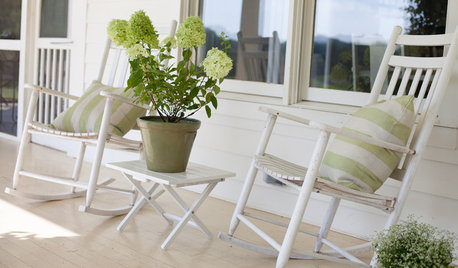

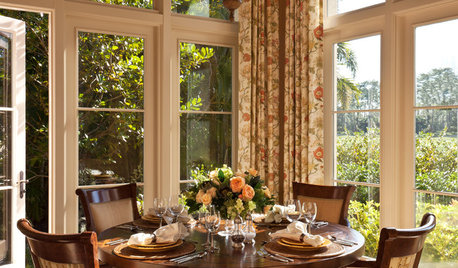
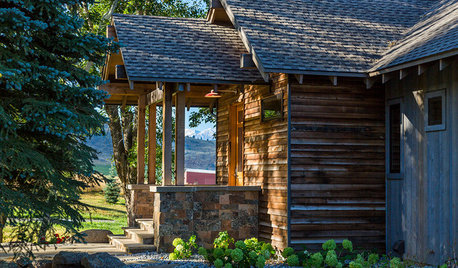
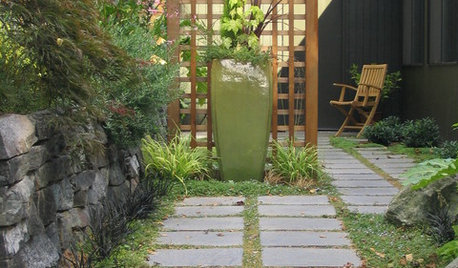
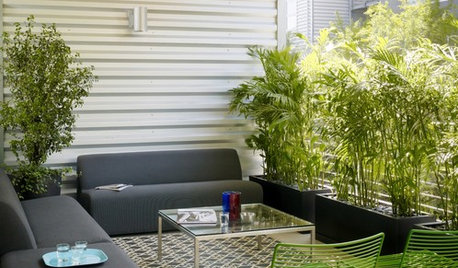
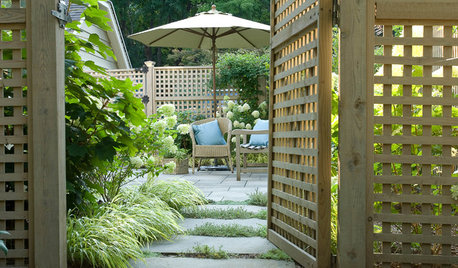

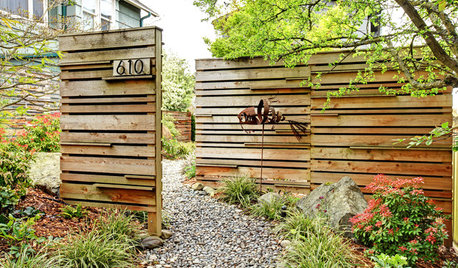






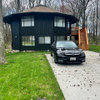

laceyvail 6A, WV